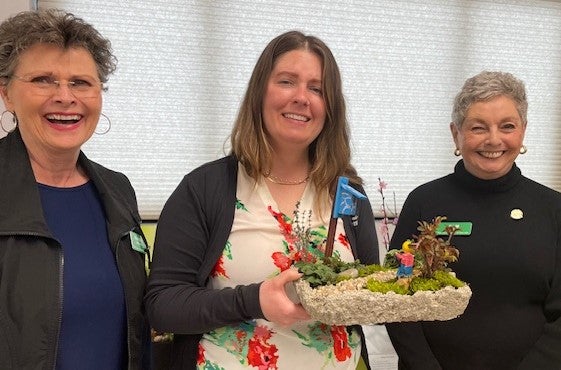Garden Club of Danville teaches container gardening
Published 4:00 pm Monday, April 1, 2024

- Growing plants in containers was the topic for the March meeting of the Garden Club of Danville. Alexis Sheffield, Boyle County Extension Agent for Horticulture, explained the basics of growing flowers and vegetables in containers, from small dish gardens to large raised beds. From left to right, Margie Andrus, Sheffield, and Sam Swain, Garden Club president. Photo submitted.
By Susan Jonas, Garden Club
Using containers is a great way to garden for those who don’t have the space, time, or inclination to plant a garden in the ground. The Garden Club of Danville March meeting was all about using containers and raised beds. The advice came from an expert, Alexis Sheffield, Boyle County Extension Agent for Horticulture and co-owner of Wild Roots, a cut flower farm in Mercer County.
Growing plants in containers and raised beds allows gardeners to use non-typical spaces like paved patios and porches. Pots of any size or shape are a good way to contain aggressive spreaders like mint. Plants raised above the ground are less likely to need weeding, too.
Sheffield reminded gardeners that plants in containers still need the same things in-ground gardens need: good soil, water, and nutrients. Use a good quality potting soil or make your own. Sheffield recommends one part each compost, vermiculite or perlite, and peat or coconut coir. Toss in a handful of garden dirt for the microbes that keep the whole mix alive.
Pots need not be restricted to flowers, especially with all the vegetables being cultivated for containers. Smaller tomato plants, peppers, cucumbers, and others are now widely available as starter plants in the spring. A pot of spring lettuce is a welcome sight in early spring and simple to start from seed. You can easily move potted plants to a sheltered location if late frost threatens.
You can buy pots already planted or make your own from scratch with smaller plants. Just be sure the plants have similar soil, light, and moisture requirements. Doing it yourself requires more effort, and you’ll wait a little longer for a full container, but it can save money.
Don’t restrict potted plants to the porch or patio. Set a planted container, maybe even a small shrub, in a bare spot in your border. It’s a great way to test whether you like the plant there.
Water pots regularly when the soil is dry one inch below the surface for smaller pots, two inches for big pots.
Large terracotta pots, especially those with an aged patina, are much prettier than plastic, but they have their drawbacks. Because the clay is porous, the pots dry out much faster than plants in plastic. To prevent this, set a plant in a plastic pot inside a slightly bigger terracotta pot on a bed of woodchips that fills the remaining space.
The soil in the plastic pot will remain moist and cool but excess water will drain through. The airspaces in the woodchips keep the terracotta from cracking in frosty weather. You can easily change the plantings in your clay pot several times a year using this technique. If you need to move the big pot, it’s a lot easier to take the plastic pot out first and move them separately. Terracotta is so much prettier than plastic that it’s good to know how to make the best of both.
Raised beds are also containers of a sort. Most often used for vegetables, they allow for improved soil on top of poor or compacted soil, and easier access and weeding. They warm up sooner in spring and, like pots, can be adjusted for specific soil types.
The Garden Club of Danville meets the first Wednesday of every month except January and July, at 1:00, usually at the Boyle County Extension Service, 99 Corporate Drive. Visitors are welcome.






